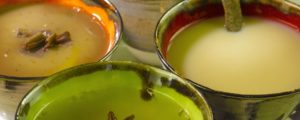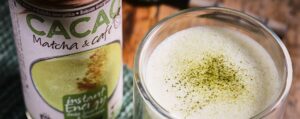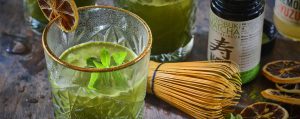What is Matcha?
Matcha is Japanese green tea ground into powder. It is made from the leaves of the Camellia sinensis tea plant. What makes this unique green tea so special is that it contains a lot of antioxidants, vitamins, minerals and amino acids. This is due to the origin and method of production of this green tea. The different ways of treating the green tea leaves determine the tea quality. There is only a small Japanese elite of tea farmers capable of producing high-quality Matcha.
The history of Matcha tea
Tea was traditionally considered a medicine. To absorb the natural and healthy components of tea, the obvious solution was to grind steamed tea leaves into a fine powder. Matcha was born!
In 1191, Zen Buddhist Eisai brought this new revolutionary method of drinking tea from China to Japan. He noticed that drinking matcha improved his Zen meditation sessions by inducing a state of calm alertness. Master Eisai travelled all over the country and planted tea everywhere. But matcha was long “the secret medicine” at the court of the emperor and elite.
In the 16th century, another Zen master reinvigorated the history of tea in Japan: Sen-no-Rikyu created the tea ceremony, in which matcha plays the leading role. With the tea ceremony, this special green tea broke through among the Samurai, the Japanese caste of warriors. They used it as a meditation drink.
Today, drinking matcha is an integral part of Japanese culture and this green tea enjoys growing fame. But producing the highest quality matcha remains an art.
Special production process of matcha
Matcha is Japanese, green tea ground into powder. Its plantations look very different from other tea fields. 4 weeks before harvest, they cover them with dark tarpaulins. This gives the tea plants 90% less sunlight. To compensate, the tea plants start producing intense chlorophyll and the leaves produce very high levels of amino acids. A mildly sweet flavour and brightly coloured green leaves are the result.
- The fresh young tea leaves are harvested only once a year, in spring and by hand. During harvesting, only the finest tea leaves are selected. They are then taken to the factory as quickly as possible where they are steamed over water vapour to stop fermentation, keep the leaves fresh green and preserve their nutrients. They are then dried at a temperature of 180°. The dry leaves are now renamed ‘Aracha’ or ‘raw tea’.
- These dried tea leaves are now graded into different quality categories according to colour, taste and texture. They then go through various machines that remove the stems and leaf veins so that only the very best green ‘leaf meat’ remains. The tea leaves are then cut into even shapes. This is called ‘Tencha tea’.
- The superfine leaves are then sorted according to colour, taste and aroma. This creates as many as 100 Matcha blends or qualities. There is one for culinary use (cheaper), for beginners (less refined taste), ceremonial tea (more expensive) and Premium Matcha (most expensive). A specialised tea taster decides on quality and price. Tencha, Gyokuro and Kotobuki meet the highest possible quality level of green tea.
- As the final step in the matcha green tea production process, these different Tencha blends are ground into powder on granite stone mills. This is done extremely slowly: 30 to 40 g per hour. Tencha, Gyokuro and Kabusecha are ‘overshadowed’ teas. All other Japanese teas (Sencha, Bancha, Hojicha and Genmaicha) are grown without shade.
The grade of matcha largely depends on the quality of the Tencha, which depends on the region, the geographical conditions (lowland, hilly or mountainous), the experience of the tea farmers and the variety of the tea plant.
Matcha has the typical umami flavour
Good quality matcha has the typical umami flavour. ‘Umami’ is the pleasant, sweet, full-bodied flavour that comes from the amino acids in the tea. Besides sweet, sour, salty and bitter, it is called the fifth flavour.
The more amino acids matcha contains, the higher the quality. They help deeply relax and bring mental clarity while studying. It is the ideal state to relax, learn novelties and boost our creativity. L-theanine is an amino acid found almost exclusively in green tea.
Sado or the Japanese tea ceremony
The way of tea, called ‘chanoyu’ or ‘chadõ’ (pronounced ‘Sado’) in Japanese, is the Japanese art of tea making. The tea ceremony is all about creating the right environment to enjoy a perfect cup of tea.
Its 4 basic principles are: harmony (wa), respect (kei), purity (sei) and silence (jaku).
In the way one performs the ceremony, the influence of Zen Buddhism is evident. The use of spring water is recommended over mineral water. Mineral-poor water such as Pineo is quite suitable for brewing green tea of premium Gyokura or Kimigayo according to the rules of the art.
How do you make matcha?
- Put 1 gram (1/2 teaspoons) in a matcha bowl.
- Add about 80 ml of boiled water that has cooled to about 80 degrees and gently whisk the tea with a bamboo whisk for 15 sec to form a frothy liquid.
- Never fill the tea bowl to the brim, but up to 2 fingers from the rim.
- While frothing the green tea, you can already enjoy the slowly rising aroma.
Consciously sip your green tea. The taste is pleasant, mild and at the same time intense and strongly aromatic.
“One cup of Amanprana matcha tea contains the same nutritional value and antioxidant content as 10 cups of ordinary green tea. Actually, you can’t compare the two. With matcha, you drink the whole leaf, the whole thing. With green tea, just the extract.”
Where is matcha produced?
AIYA is Japan’s most renowned matcha producer and has been since 1888. Many tea farmers have been working with them for generations. The company is based in Nishio, Aichi, in Japan. Nishio is the centre of Japan’s matcha production and one of the oldest growing regions for tea in the world. The first tea plantations emerged here as early as around 1200.
Nishio boasts ideal conditions for tea cultivation: humid hot summers, clear, clean rivers lining the growing region to the west as well as to the east, fertile soil, close to the warm southern coast of Japan and far enough away from the larger population centres to have enough space for pure tea.
The quality of matcha coming from the Nishio region is reflected by its dominance in the market: over 60% of all Japanese matcha teas come from this region.
In the early 1970s, the president of AIYA had a vision: to manufacture top-quality Japanese green tea organically. Well before organic products became popular, he gathered the best tea farmers around him and started growing green tea ecologically with them. Their commitment to the well-being of nature translated into helping (both financially and physically) reforest mangrove forests in Thailand over the past 15 years.
Matcha as a superfood
The exceptionally high ORAC value of 168.500/100 grams (A method of expressing the antioxidant value of food) makes this tea a powerful antioxidant. This is mainly due to the EGCGs (Epigallocatechin gallate) found exclusively in green tea. The antioxidant activity of matcha scores much higher than other known superfoods such as blueberries, pomegranate and broccoli. EGCG does not affect the glycaemic index, is high in fibre, vitamin C and E. Besides antioxidants, this unique green tea also contains amino acids, of which L-theanine is the most notable for its calming effect. Amanprana’s Kotobuki Matcha tastes slightly more bitter than other top matcha, due to its higher tannin content.
Matcha is full of extra chlorophyll
Matcha owes its bright green colour to a huge chlorophyll content in the leaves of the green tea. While growing in the shade, they produce an extra amount of chlorophyll.
What is chlorophyll?
Hans Fischer (physician and organic chemist Nobel Prize winner 1930) was particularly concerned with pigments in blood and chlorophyll in leaves. He discovered that the chemical composition of chlorophyll is 98% identical to our blood. Chlorophyll is the ‘blood of the plant’ and has a wide range of activity.
Unlike ordinary green tea where you drink an infusion of the leaves and discard the leaves themselves, with matcha the tea leaves are ground into powder. You ‘drink’ the powdered leaf, as it were, and all the vitamins, minerals, antioxidants and ballast substances are included.
Gula Java Matcha Organic
Amanprana markets a combination of Gula Java (coconut blossom sugar) and matcha. Kotobuki quality is used for the matcha. ‘Kotobuki’ in Japanese means ‘long life’ and ‘blessing’. It refers to the high nutritional value of the Kotobuki quality. With its low glycaemic index, Gula Java coconut blossom sugar ensures slow energy release.
Matcha from Amanprana
Tea
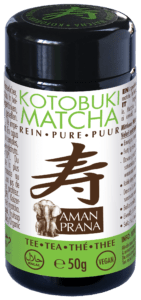 Read more about Tea
Read more about Tea
Sports drinks
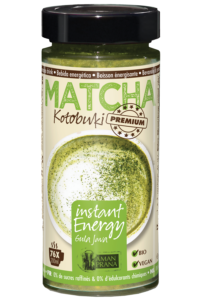 Read more about Sports drinks
Read more about Sports drinks
Sports drinks
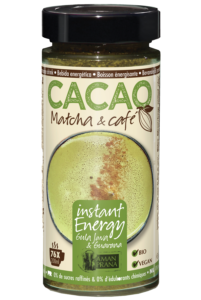 Read more about Sports drinks
Read more about Sports drinks
Sports drinks
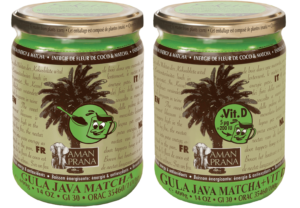 Read more about Sports drinks
Read more about Sports drinks

